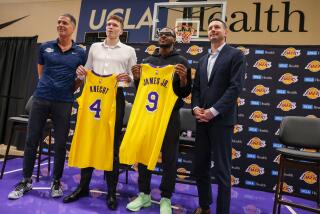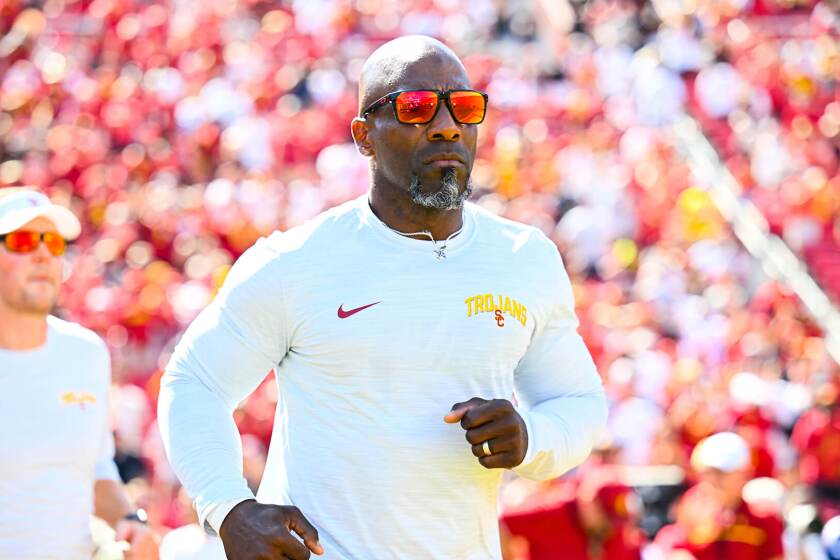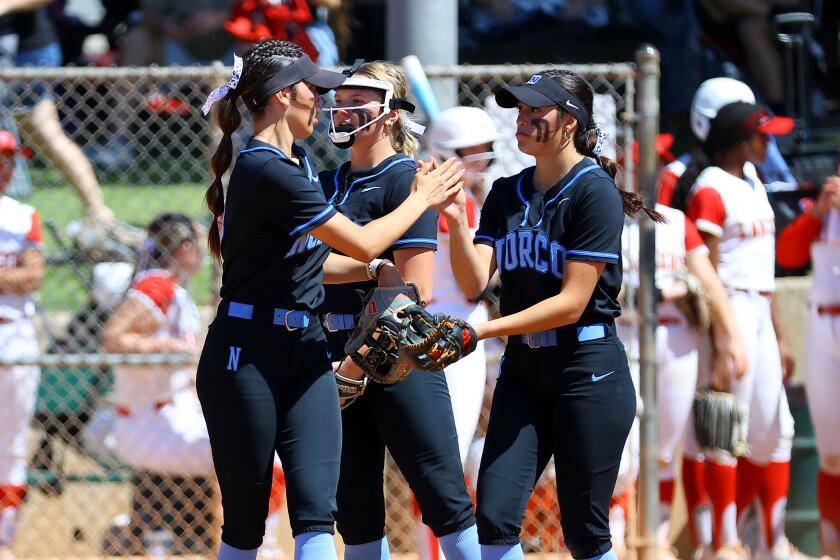The Evolution of Younger Athletes in Professional Sports
- Share via
The first professional football player was a 16-year-old high school star recruited-for $10-by a YMCA team in western Pennsylvania as an emergency fill-in at quarterback. That was in 1895, so the controversy caused by Alabama linebacker Keith McCants and about two dozen others pushing their way into the NFL draft next Sunday is more about quirks and contradictions than history.
Until Spencer Haywood yelled foul and took the National Basketball Assn. to court 19 years ago, only athletes were denied the right to sell their services to an employer whenever they chose. The restrictions, though written differently, amounted to denial into the major pro basketball and football leagues until four years after a player’s high school class had graduated.
What evolved as a result of Haywood’s victory is a fascinating mix of cooperative progress and resistance.
Basketball is moving toward a system that might, in a few years, allow its athletes the full flexibility everyone outside sport enjoys. The final gesture would be players permitted to apply for the pro draft and welcomed back to college, with no loss of eligibility, if that seems the wiser option.
Football is nowhere near such a system. Though undergraduates will be included in droves as never before this year, it might not last. The reason is a wage scale the NFL might impose before next year’s draft that would cause salaries for rookies to plummet.
Under the proposed scale, rookies would sign two one-year contracts for $60,000 and $70,000. Signing bonuses would start at $500,000 and fall to $100,000 for the 28th, and last, first-round pick. These wages still are beyond the imagination of most college graduates. But the first pick in last year’s draft, quarterback Troy Aikman, was given a $2.75 million signing bonus; the figure for the player chosen last in the second round, or the 54th pick overall, was $250,000.
McCants, by seeming out of condition and uncooperative during recent workouts for NFL teams, might no longer be the top pick. With that prize, gained by having the worst record in the league last season, the Atlanta Falcons say they are leaning toward another underclass eligible, quarterback Jeff George. In all, at least six of the 22 early entries are expected to be first-round selections.
Born into poverty in Mobile, McCants is fond of saying: “I knew there were two paths in life and one of them led nowhere.” As Spencer Haywood realized at about a similar age nearly a generation ago, the shortcut path that leads to professional sports is anything but uncluttered.
The early-entry process in the NBA has included a name change and five years of amnesia. A recent league publication said: “The 1990 NBA draft will mark the 15th year that the Early Entry rule for draft eligibility will apply.” That suggests Phil Chenier and more than two dozen others were jump-shooting and rebounding phantoms, because early entries into the NBA started not in 1976 but in 1971.
The route through which Chenier and five other Haywood-inspired pioneers sought to enter the NBA was called the Hardship Draft. Little wonder many in the league cringe and offer selective memory, because at best the earliest early entry procedure was an embarrassment.
For most other families and nearly every other American business, passage for a son from school to life’s work is a time for hopeful celebration. Not so for the Cheniers of Berkeley. If the most devious thing Phil might do for them was steal an opponent’s pass every game or so, why were his new employers snooping around his neighborhood?
“We never figured out why either,” Chenier said the other day in his Columbia, Md., home. “But investigators came questioning our neighbors. Supposedly, the league was going to refuse players it felt did not qualify as hardship cases.”
Quiet intimidation is what it seems on hindsight, because Chenier and the rest were about to stir disruption of cozy collusion between colleges and pros that Haywood some months earlier had created.
With its restricted-entry rule, the NBA got from the colleges a cost-free developmental program, publicity buildup for players and immense goodwill.
What could spoil such bliss?
Competition.
The new American Basketball Assn. figured a way to survival (meaning eventual merger with the NBA) was to trash its own restricted-entry rule and admit collegians with postgraduate ability. An Olympian the year before and a sophomore at Detroit University, Haywood in 1969 was such a player.
“I was making $15 a month in school (allowed under NCAA scholarship rules at the time),” Haywood said in his autobiography. “When someone says you can make $100,000 a year, you start listening.”
How to grab the 19-year-old Haywood and infuriate the colleges as little as possible was solved by an agent named Steve Arnold. According to Don Ringsby, a former co-owner of the Denver team that chose Haywood during a secret ABA draft and signed him: Arnold “came up with the ‘hardship’ gimmick whereby we could plead for a waiver of the (four-year) rule on the basis of financial hardship. He knew Spencer came from a poor family in the Deep South. Arnold just invented it. It was a gimmick. And Jim Gardner, the president of the ABA, okayed it.”
A contract dispute with Denver led Haywood on Dec. 20, 1970, to sign a six-year, no-cut deal with the NBA SuperSonics for $1.5 million, to be paid at the rate of $100,000 for 15 years. Even though Haywood had been a pro for more than a year, NBA Commissioner Walter Kennedy earlier had said no NBA team could sign him. Not until June 1971 would it be four years after his high school class graduated.
Haywood sued and finally won. The federal district court judge who ruled in his favor, Warren J. Ferguson, wrote: “It is uncontested that the rules in question are absolute and prohibit the signing of not only college basketball players but also those who do not desire to attend college and even those who lack the mental and financial ability to do so. As such, they are overly broad and improper.”
The wailing was both immediate and loud.
NBA Commissioner Kennedy: “This could kill college athletics and seriously injure professional athletics.”
Northwestern football coach Alex Agase: “This could eliminate all superstars from college competition.”
Furman basketball coach Joe Williams: “This will take a great deal of incentive out of recruiting good players.”
The colleges, of course, could have simplified matters-and purified themselves-by going back to using student-athletes. Instead, a grudging compromise came about in the NBA, the hardship “gimmick” Arnold had devised several years earlier for the rival league. Into the uncharted waters came Chenier.
“I first thought about it during trials for the 1971 Pan Am Games,” he said. “I’d befriended (University of Minnesota forward) Ron Behagen, who introduced me to two agents from New York. They said a couple of NBA teams were interested. I’d just finished my junior year at Cal.”
Chenier was frustrated by losing to John Wooden’s nonpareil UCLA teams-and when a very good transfer to Cal decided to return home to Nebraska, he opted to apply to the NBA. Nineteen years later, he said: “I didn’t feel I was in a hardship situation.”
The NBA’s investigators very likely agreed. But Chenier, Cyril Baptiste, Joe Hammond, Ed Owens, Tom Payne and Nate Williams were part of a supplemental draft. Baptiste, Payne, Williams and Chenier were first-round choices, with Hammond a fourth-rounder. Owens was not chosen.
“The deal was pretty much secure ahead of time,” said Chenier, meaning money. Still, he thought the deal was with the Chicago Bulls and was flabbergasted when the Bullets drafted him.
Of that six-player class, only Chenier had a long and productive NBA career. Chenier has not regretted his decision. The only time he feels even mildly guilty is when he talks with his teenage son and daughter.
“It’s very difficult for me at this point to say to the kids upstairs (he also a daughter in college): ‘Hey, school’s important. You’ve got to get your degree.’ I tell them I made some mistakes. There were certain areas where I did not achieve what I could have. But you shouldn’t set your goals in accordance with someone else’s.”
Chenier has an associate degree in computer science from Howard Community College, where he works in student activities. Also an analyst on Bullets telecasts, he hints at possibly trying to make up the 30-some credits he needs for a bachelor’s degree.
“When I talk with youngsters (exceptional at basketball), I don’t want to feel hypocritical by saying: ‘Oh no. This (NBA) dream can’t be met. You can’t achieve this.’ Some can. To cut short one’s dream is just as wrong as trying to lead somebody down the wrong path.”
No one has put the early-entry issue any better, for when to grab for the dream is as uncertain as at the dream itself. Over 19 years, the NBA lists 184 players as having traded college eligibility for a shot at pro riches.
That’s not entirely accurate, because the tally includes at least two merry men who treated the NBA in the manner of a public-course golfer trying to crack the Masters. Not long after being told, about two years apart, that injuries had ended low-level college careers for them, Reinhard Schmuck of Baruch and Dick Whitmore of Brown applied for the NBA draft.
Whitmore and a classmate, Arthur Jackson, decided he should petition the NBA as a way of understanding how a pro league operates. Both had aspirations of a career in sports management.
“I wrote to Commissioner David Stern (last year), but got no response,” said Whitmore, whose severe knee injury came early in his junior season. “I got no response. When I mentioned what I’d done to our sports information director, he put it on the (news service) wire.”
The barrage of publicity forced the NBA to include the whimsical Whitmore on a 14-name list of candidates that featured Nick Anderson, Vlade Divac and J.R. Reid. That meant that the latest NBA draft also had something odd.
Early entry is old enough so that a sixth-round choice by the Hawks in 1973, John Williamson, has a son at LSU who could consider it. An Ivy Leaguer, Brian Taylor of Princeton in 1972, scooted to the pros before anyone who played for Jerry Tarkanian. One player, Luther “Ticky” Burden of Utah, applied for the 1974 draft, withdrew, then went through the process again the next year and was taken by the Knicks on the second round.
When Schmuck took his Whitmore-like lark in 1987, an NBA official went to the trouble of phoning to tell him not to show up for the draft. Schmuck’s coach at Baruch, Ray Rankis, had applied 13 years earlier.
“I don’t think they took me too seriously,” Rankis said, “because I wrote my application in crayon.”
Moses Malone showed that a high school player could jump immediately into the pros and become wildly successful; Darryl Dawkins and Bill Willoughby showed the leap might be too high even for the unusually gifted.
That’s subject for debate, because Dawkins was chosen in the first round of the 1975 draft by the 76ers. Willoughby was a second-round choice, by the Hawks. Both made considerable money over decently long careers in the NBA and might well have been unsuited for academics beyond high school.
Chenier says: “If you’re not going to be a first-round draft choice, it really doesn’t make a lot of sense to come out. Very few second-rounders get no-cut contracts.” In the NFL, being selected in the second and third round still is honorable.
No significant trends in basketball are obvious. Four of the six players in Chenier’s class were first-rounders; only one player among the eight who applied the second year, Bob McAdoo, went that high. Twenty players applied in 1974; a total of 15 applied from 1977 through 1979.
“Each step in college basketball for most players is another step forward in maturity,” said Bullets General Manager Bob Ferry, who drafted Chenier in 1971 and whose son Danny considered early entry at Duke after the 1989 season. “Some players don’t belong in college but are forced to be there (because its system serves as the best training area for the NBA).
“Part of the experience in college is learning to handle pressure. Part of it is learning to handle responsibility. I think a player like Darryl Dawkins missed that.”
But what about Ralph Sampson? What if, after his sophomore season at Virginia, he had listened to Red Auerbach and opted for the pros?
“I don’t know Ralph Sampson,” said Ferry. “But there is a factor with some players where they’re sheltered and protected to the point where that becomes a negative and retards their development as a player.”
The NFL has been feeling early-entry pressure since at least 1975, when Commissioner Pete Rozelle disapproved the contract between Clarence Rose and the Houston Oilers but later changed his mind.
Its policy of denial began in 1926, because Red Grange turned pro shortly after his final game at Illinois, earned a quick $100,000 in a series of exhibitions and angered the colleges. Earlier in the century, many players routinely played for their colleges on Saturday and for pro teams the next day.
Like the NBA in its early stages, the NFL until this year mostly used supplemental drafts for underclassmen. A second-string Alabama teammate of McCants, Danny Cash, jumped after being dismissed from school. A Houston linebacker, Lamar Lathon, said he wants to use his money to underwrite drug rehabilitation for his sister.
Few who declared early are linemen, the opinion among college and pro personnel experts being that it takes more time for larger players to mature. Along with lots of other scare stuff over the years, that also might be bunk. All Spencer Haywood and years of manipulation guarantees is the right to choose, not the inspiration to make the right choice.
More to Read
Go beyond the scoreboard
Get the latest on L.A.'s teams in the daily Sports Report newsletter.
You may occasionally receive promotional content from the Los Angeles Times.










